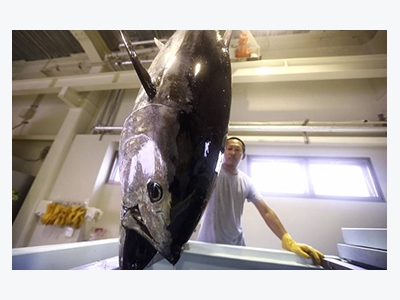Japanese closed-cycle bluefin farms to produce commercial volumes

Multiple bluefin farms in Japan are set to drastically increase shipments of closed-cycle tuna, for which the entire cycle of reproduction is carried out in the captive state.
Nagoya-based trading company Toyota Tsusho Corp. has had a technical tie-up since 2010 with Kinki University – the first to succeed in closed-cycle bluefin breeding – and now operates two tuna farms, in Okinawa and Nagasaki prefectures. A subsidiary, Tuna Dream Goto, operates a bluefin nursery in Goto City, Nagasaki Prefecture. The university sells under the Kindai Tuna brand.
The business plan for the nursery center envisaged annual production of 60,000 fry in the fiscal year ended in March 2017, with the focus on acquiring skills for cultivated nursery production. In the 2018 fiscal year, the operation is scheduled to go into full-scale mass production, with an output of 200,000 fry. The number is then planned to rise by an additional 50,000 annually in 2019 and 2020. The fry are moved from the nursery center to nearby offshore nets to grow into juveniles. Then they are transferred to Okinawa for further growth. The whole process from hatching to harvest takes about three years. Current annual production of fattened tuna is now 3,500 to 4,000 fish, with plans to raise that to 6,000 in 2020. About 2,000 fish are expected to be exported annually.
Another farming operation, run by Maruha Nichiro, which was the first private company to master closed-cycle bluefin breeding, is also taking off. Tokyo-based Maruha Nichiro Corp.’s bluefin operations, operated by subsidiary Amami Yougyo, are located off Amami Oshima Island in Kagoshima Prefecture. The operation began commercial shipments in 2015, with substantial amounts shipped from 2016. They have opened a new aquaculture site for hatchery-reared juveniles in Oita Prefecture to be used as hatchery yields increase. In 2020, the company expects its total output of bluefin to be 4,300 metric tons (MT). An individual fish at harvest typically weighs 50 kilograms, so that works out to nearly 54,000 fish. The company has contracted to supply the fish to the Aeon supermarket chain.
Two other operations are also making progress. Kyokuyo Co., Ltd., based in Tokyo and working with Feed One Co. Ltd. of Yokohama, a feed producer that has formulated special blends for bluefin using scallop byproducts, expects to start shipments in fiscal 2017. It will supply 200 tons of closed-cycle bluefin in fiscal 2018 under the Tunagu brand. The company has developed fish farms off Kochi and Ehime prefectures. And Nippon Suisan Kaisha, Ltd., headquartered in Tokyo, also aims to ship 10,000 tuna, or 500 MT in fiscal 2018 and 1,000 MT in fiscal 2019 from its Oita Marine Biological Technology Center under the Kitsuna Gold Label brand.
Getting tuna to breed, and the juveniles to survive, is difficult. They breed only over the age of five, and under particular conditions. Kinki University (Kindai) in Wakayama Prefecture was the first to succeed in captive breeding, using six- and seven year-old tuna, but initial survivability was low. Of the 190,000 eggs they hatched in 2009, only about 40,000, or 0.5 percent, survived to the fingerling stage. There is additional mortality after that, especially when transferring to ocean pens.
However, over several years of trial production, survivability has been brought up to a level which, though still low, may contribute to the bottom line. The bigger payoff is expected if and when the harvesting of juveniles for stocking aquaculture pens is banned, due to further decline of the species. Until that happens, it is still cheaper and more profitable to stock pens with wild-caught fish.
Closed-cycle breeding is considered more sustainable than harvesting wild juveniles, as it does not deplete the wild stock, though it still takes a lot of wild fish, such as mackerel, to fatten the tuna, which have a low feed conversion ration compared to other farmed fish like salmon.
Investors seem to be betting on the further decline of the bluefin stock – a pretty safe bet, considering continued overfishing. The share prices of Maruha Nichiro Corp., Kyokuyo Co., Ltd., Nippon Suisan Kaisha, Ltd. and Feed One Co., Ltd. have risen sharply in 2017, as their investments in closed-cycle Pacific bluefin tuna farming appear set to add to their profits.
About Author: Chris Loew - Contributing Editor reporting from Osaka, Japan
Related news
 Vannamei Shrimp Key to Export Growth in India
Vannamei Shrimp Key to Export Growth in India INDIA - Introduction of exotic ‘vannamei’ shrimp into India’s coastal aquaculture system has significantly contributed to maintaining the momentum
 Australia Suspends Uncooked Prawn Imports
Australia Suspends Uncooked Prawn Imports The Director of Biosecurity has suspended uncooked prawn imports into Australia in response to information from the Department of Agriculture
 New Disease Detected in Vannamei Shrimps
New Disease Detected in Vannamei Shrimps A new virus among Vannamei shrimps, in Thailand and Vietnam, has been detected by the department of Marine Living Resources of Andhra University
 Hopes Are High for Torula Yeast in Shrimp Aquaculture
Hopes Are High for Torula Yeast in Shrimp Aquaculture Research in Mexico has shown that torula yeast (Candida utilis) could replace portions of fishmeal in farmed Pacific white shrimp (Litopenaeus vannamei) diets.
 Women are Central to the Global Fishing Industry, Study Finds
Women are Central to the Global Fishing Industry, Study Finds Although women play a central role in the fishing industry in many parts of the world, their contribution has not been sufficiently recognised